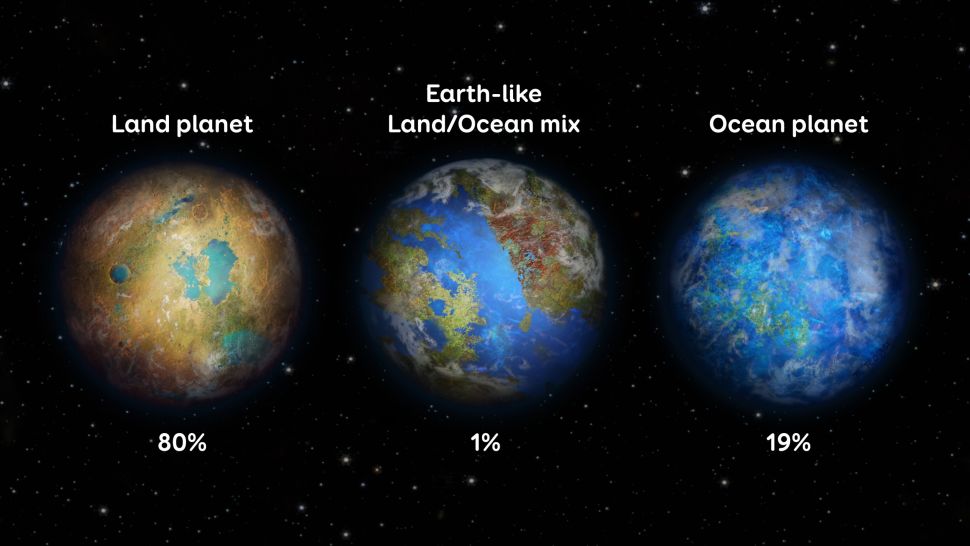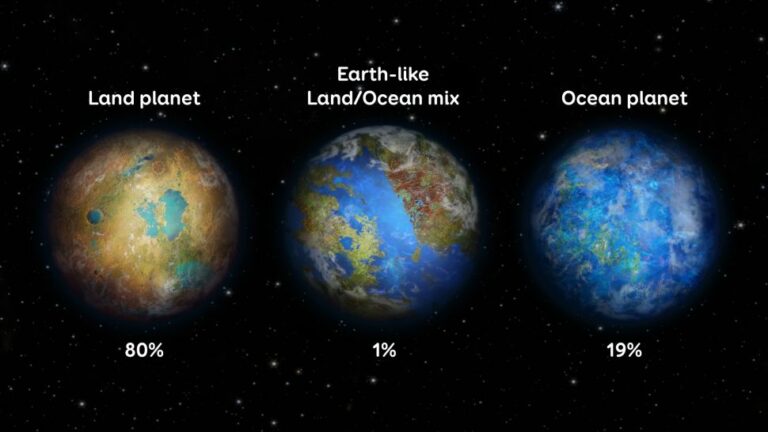‘Pale blue dot’ planets like Earth may make up only 1% of potentially habitable worlds
We may need to look for “pale yellow dots” instead.
It’s possible that Earth-like planets with ocean to land ratios close to our planet’s are quite uncommon.
In the habitable zones surrounding stars, which are regions where liquid water can exist on a planet’s surface, just 1% of rocky worlds may be Earth-like planets with around 30% of their surface covered in exposed continental land. Instead, the study discovered that around 80% of possibly livable worlds are entirely dominated by land while about 20% are entirely oceanic worlds.
The link between water in a planet’s mantle and a planet’s recycling of continental land via plate tectonics was modeled by the researchers to arrive at this result.

In a statement, Tilman Spohn, executive director of the International Space Science Institute in Switzerland and a member of the study team, stated, “We Earthlings appreciate the balance between land regions and seas on our own planet. Although it is luring to think that a second Earth would be identical to ours, our modeling findings indicate that this is unlikely to be the case.
The findings suggest that Earth’s land-to-sea ratio (1:3) is delicately balanced and that this ratio may easily tip over into either being predominantly land or mostly sea for most planets. The most likely time for this tipping point to occur, according to Spohn and his collaborator Dennis Höning, a postdoctoral researcher at the Potsdam Institute for Climate Impact Research in Germany, is when a planet’s interior has cooled down to a temperature similar to that of the Earth’s mantle, which is 2,570 degrees Fahrenheit (1,410 degrees Celsius) near the crust and as hot as 6,700 F (3,700 C) at greater depths.A planet’s dominance by land or ocean depends on how successfully subduction zones at the tectonic plate boundaries can cycle water over land at this mantle temperature.
At the end of the Archean, when Earth achieved these circumstances, it discovered the delicate equilibrium in which humans currently reside. Even Earth’s delicate equilibrium is unstable over billions of years, though we are not aware of it since the rates of change are so slow, according to Spohn. This trough may have been reached considerably sooner by other planets.
“Internal heat causes geologic activity, such as earthquakes, volcanoes, and mountain construction, and results in the expansion of continents,” Spohn stated of the mechanism behind plate tectonics. As opposed to that, “A number of cycles that exchange water between the atmosphere and the interior make up the erosion of the soil. Our computer simulations of the interactions between these cycles suggest that the Earth of today could be a unique planet.”

Other aspects were also taken into account by Spohn and Höning, such as how carbon dioxide emissions, a greenhouse gas, contribute to the carbon-silicate cycle, the planet’s long-term thermostat that regulates the climate over millions of years. They discovered that, while both worlds with a preponderance of land and water may still be livable with similar temperatures, their climates and life-forms might not be all that unlike from Earth’s.
Their flora and fauna may be very dissimilar, Spohn added.
According to the simulations, planets with a majority of ocean and less than 10% of land would likely have warm, humid atmospheres with tropical climates, whereas planets with a majority of land and a lesser percentage of water would be colder, drier, and harsher than planets with a majority of ocean. Cold deserts would cover the landmasses of these worlds, which are dominated by land, and enormous glaciers and ice sheets would be prevalent.
However, Spohn and Höning’s findings diverge slightly from those of other study groups. For tidally locked worlds, for instance, a research by Evelyn MacDonald of the University of Toronto discovered that the more land there is, the higher the average surface temperatures are generally. This was originally published by Space.com. The most well-known study on land planets, conducted in 2011 by Yutaka Abe of the University of Tokyo, found that land planets are less likely to freeze over because there is less water available for ice and snow to form than water worlds are, and that they can remain habitable over much greater distances from their star than water worlds can.Abe’s research supports the assertion made by Spohn and Höning that land-dominated planets would be far more prevalent than Earth-like or water-rich worlds.
Consequently, instead of looking for Carl Sagan‘s quintessential “pale blue dot,” astronomers should be searching habitable zones for “pale yellow dots.”
The results were presented at the European Science Congress, which took place in Granada, Spain, from Sept. 18 to 23, and the findings are described in the team’s conference abstract.
Source:SpaceCom
Do not forget to share your opinion with us to provide you with the best posts !





0 Comments